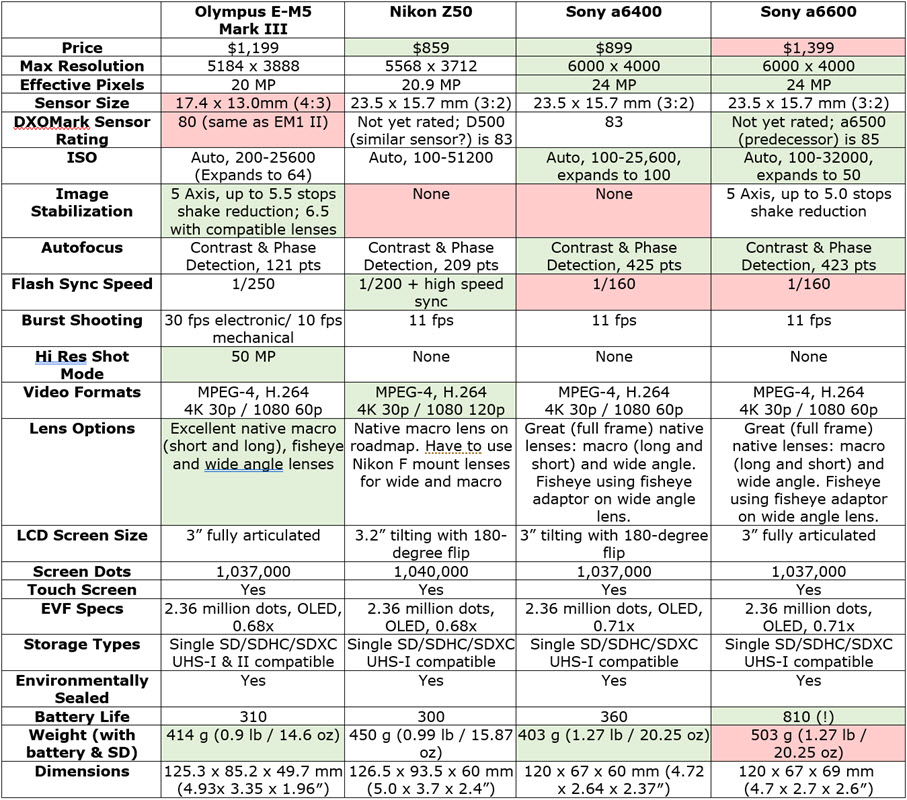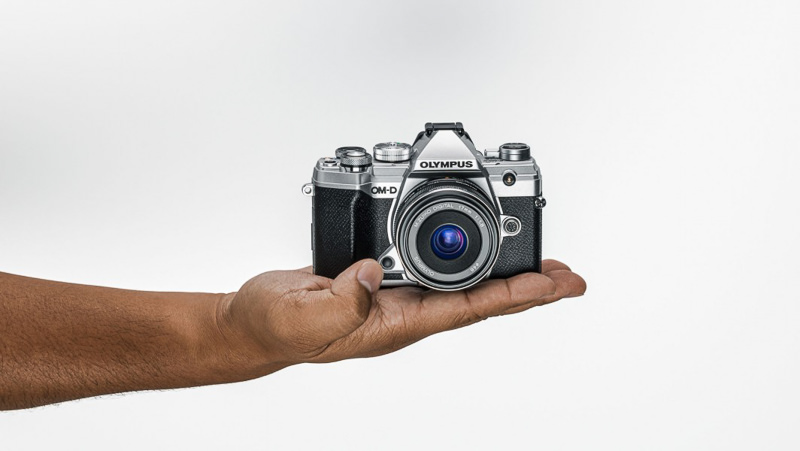Mid-range Mirrorless Roundup: Z50 vs EM5 III vs a6400 vs a6600
Nov 07
Although full-frame mirrorless cameras like the Sony A7R IV and the Nikon Z7 have been grabbing a lot of the 2019 headlines, a number of very exciting crop-sensor mid-range mirrorless cameras have also been released in 2019, many very recently. There are 4 that we have recently looked at for underwater photography over at the Underwater Photography Guide (click the links to see the initial impressions/reviews):
- Nikon Z50 Initial Thoughts
- Olympus OM-D E-M5 Mark III Initial Thoughts
- Sony a6400 Detailed Review
- Sony a6600 Initial Thoughts
Specs Comparison
There are a lot of specs to go through, and I find it’s easier when they are put into a convenient table.

Sensors
The first thing to look at is the sensors, both for resolution and sensor size. The OM-D EM5 Mark III is at a disadvantage here, as it has the smaller micro-four-thirds sensor, compared to the larger APS-C sensor of the other three cameras. Yes, it has similar resolution, at 20 MP, but when it comes to image quality, resolution is generally not as important as sensor size. Comparing the E-M5 III to any of these APS-C sensors, especially the Z50, the size of each pixel on the E-M5 Mark III sensor is noticeably smaller. This generally means lower image quality, as larger pixels allow for lower noise and higher dynamic range. As can be seen from the DXOMark ratings, the EM5 III has the lowest rating, while the a6600 has the highest, and there is a significant difference (80 vs 85).
Features
The features are fairly competitive among the cameras, though there are a few notable differences. The main things to consider are autofocus, image stabilization, video quality, size/build
Autofocus
The specs look stacked against the E-M5 III, but although it may have less autofocus points, that doesn’t mean it performs worse, especially underwater. We found that although the Sony a6400 autofocus works great topside, it did hunt a fair amount underwater, and overall seemed to perform worse than many micro four thirds systems. As the E-M5 III has the top autofocus system in the micro-four-thirds lineup, we expect it to perform better. We will have to see how the Z50 and the a6600 perform in testing. Based on Nikon’s Z6 and Z7 autofocus performance, we do expect the Z50 to perform quite well underwater; it may be the best of the bunch (that or the a6600). But don’t count out the E-M5 III!
Image Stabilization
Here, the more expensive camera bodies, the OM-D E-M5III and the a6600, carry the advantage; the cheaper a6400 and Z50 have no image stabilization. This can be a concern for underwater photography, though as long as you are shooting with strobes, it’s typically not a big deal. It’s a different story for underwater videography; underwater videographers will definitely want one of the cameras with in-body image stabilization.
Video Modes
Each of these cameras offers about the same video specs, except the Nikon Z50 has 1080/120p, compared to 1080/60p for the others.
Flash Sync Speed
The Sony cameras have quite a slow flash sync speed, which gives the advantage to the E-M5III and especially the Z50 (with high speed sync functionality) for sunball shooting and macro shooting.
Lenses
Lenses are interesting. APS-C cameras have generally been designed to just use full-frame lenses, where the smaller sensor size results in a crop factor of 1.5 (meaning that if you shoot a 60mm full frame lens on an APS-C camera, it’s the equivalent of shooting a 90mm lens on a full frame sensor). APS-C cameras have traditionally been targeted at consumers who mostly just want a nice camera they can use with the kit lens, so camera manufacturers have not put a lot of development into dedicated APS-C sensors.
That is certainly the case here, as with the Sony and Nikon offerings, the lenses that you will need for underwater use are all full frame lenses. This means they are larger and more expensive than a corresponding lens designed specifically for APS-C sensors. This is the big advantage of the Olympus OM-D E-M5 III; with all of the great micro four thirds lenses out, it has great native options for fisheye, wide angle zoom and macro lenses, and the smaller sensor size allows the lenses to be significantly smaller than their full frame competitors.
On the other end of the spectrum, the Nikon Z-mount lens lineup does not have any good lenses for underwater use (yet), so a Nikon FtZ adapter has to be used, alongside Nikon dSLR full-frame F-mount lenses.
Body & Build
All of these cameras are designed to be small with the OM-D E-M5 III the smallest camera body. The a6400 is a bit lighter, but when taking the lenses needed into consideration, this gives the advantage firmly to the Olympus. Battery life ratings are roughly comparable, and should be sufficient to get two dives in between battery changes, except for the a6600, which has so much battery life you should be able to get 3 or 4 dives between battery swaps.

One of the best things going for the OM-D E-M5 III is it’s small size and weight, as well as the small size and weight of its native lenses.
Overall Comparison
Wait, that’s it? Nothing else to talk about? Well yes, there are some other differences in specs, but really what matters most for underwater photography are sensor/image quality, autofocus, and lenses. This is weighed against cost, size and weight considerations, especially if you like to travel light. So let’s look at what it takes with each camera here to get a nice underwater macro photography system.
- OM-D E-M5 III with 60mm macro lens (120mm full frame equivalent): $1200 + $500 = $1700; 414 g + 186 g = 600 g
- Nikon Z50 with FtZ adapter and Nikkor F-mount 105mm micro lens (157.5mm full frame equivalent): $860 + $250 + $900 = $2010; 450 + 135 + 750 = 1335 g
- Nikon Z50 with FtZ adapter and Nikkor F-mount DX 85mm micro lens (127.5 mm full frame equivalent): $860 + $250 + $520 = $1630; 450 + 135 + 355 = 940 g
- Sony a6600 with 90mm macro lens (135mm full frame equivalent): $1400 + $1100 = $2500; 503 + 602 = 1105 g
- Sony a6400 with 90mm macro lens (135mm full frame equivalent): $900 + $1100 = $2000; 403 + 602 = 1005 g
OM-D E-M5 Mark III: Smallest and most compact
If you want the cheapest and lightest setup you can get, with a nice snappy autofocus system, the OM-D EM5 Mark III is the best option. However, this option is the same price as the Z50 with 85mm DX macro lens, though it is still significantly lighter. It is also only $300 cheaper than the Z50 with 105mm macro lens, or the Sony a6400, both of which will give better optics and better image quality (though in the case of the Sony, worse autofocus performance). The in-body image stabilization helps the case for videography, as does Cinema 4K video mode. Outside of 24 fps Cinema 4K, expect lower video quality than the competitors. It would be great if this camera were $100-200 cheaper though…the only saving grace here is the great native lens selection, as without that, the E-M5 III body by itself is outclassed for the price.
Sony a6600: Most expensive and best quality
If you want the best image quality and you’re willing to spend some extra money, the a6600 is a great bet. Same with videography; this setup will give higher quality video than its competitors, with a high amount of in-body image stabilization to boot.
Nikon Z50: Best Performance/Cost Ratio
Although larger, and either the same price as the E-M5 or a bit more expensive, the Z50 gives a bump up in sensor spec, and we expect also a bump up in autofocus performance. If going with the 105 mm lens, the optic quality will be better than the Olympus 60mm, though that comes at a cost (money-wise and weight-wise). But if you are willing to spend the extra $300 and carry around the extra 700 g, this is a high performing macro setup for a relatively low cost, and looks like the best value option of this comparison.
Sony a6400: Low Cost, High Video Quality
The a6400 takes great video, but unfortunately does not have in-body image stabilization. For videographers used to going to great lengths to keep their video rock stable (like macro videographers with large underwater tripod systems), this is a great low-cost option which will provide excellent high quality video. For stills, the Z50 and the E-M5 III may both be better choices on account of the autofocus and lens selection.





Related Articles
Popular Articles